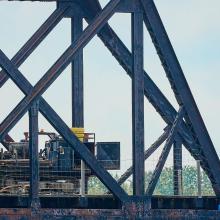Image set

Related services
Related sectors
Related regions
Opening article section
Article section
Rich text
The integration of artificial intelligence (AI) into non-destructive testing (NDT) is transforming the way we assess the integrity of critical infrastructure, such as bridges, different types of dams, wind turbines and more. This article provides an overview of AI-driven NDT, analyzes the contributions of automation in defect detection, and takes an in-depth look at the prospects for large-scale development.
Rich text
The rise of AI in non-destructive testing analysis
Non-destructive testing (NDT) is increasingly used to assess infrastructure integrity. Conventional methods, which rely heavily on human expertise, can be intrusive and restrictive, both for the organization and for users. NDT offers rapid, non-invasive measurements, generating a significant amount of objective data.
The rise of AI is addressing these realities. By automating the analysis of NDT data and improving early defect detection, it is helping to tackle a major challenge for public safety and infrastructure sustainability.
Rich text
Limits on traditional inspections
Traditional inspections are struggling to keep pace with accelerated infrastructure aging for a number of reasons:
- Lack of qualified personnel
- Growing volume of data to be analyzed
- Health and safety risks for inspectors and users
Without automated tools, subtle defects such as micro-cracks and internal voids can fly under the radar, resulting in costly repairs or major failures.
Rich text
AI and non-destructive testing: harnessing their full potential
To effectively determine the potential contribution of AI to non-destructive testing analysis, a structured review of the state of knowledge of AI applied to these technologies (NDT) was needed. This involved:
- Mapping global research
- Evaluating the quantitative gains (accuracy, time, cost) of machine learning algorithms
- Proposing a roadmap for safe development
Rich text
Study methodology
The methods, tools, techniques and types of analysis used to achieve these objectives are as follows:
- Structured literature review: a search in Scopus returned 4,737 documents
- Comprehensive mapping
- Bibliometric analysis carried out with VOSviewer (542 keywords, four large clusters)
- Critical analysis of recent case studies (drones over bridges, wind turbine blades, digital twin technology)
- Patterns were cross-referenced with predictive maintenance repositories and emerging standards.
Rich text
Key results: improved accuracy, timelines and costs
The key findings of our research into how AI enhances NDT are:
- Scientific mapping: Acoustic, mechanical, material and structural quality NDT form four highly interconnected clusters.
- Increased accuracy: Neural networks capable of detecting micro-cracks not visible to the naked eye; +15% to +25% detection compared with conventional visual inspections.
- Time savings: Automated processing of thousands of radar/ultrasonic images in just minutes (70% reduction in time normally taken in the field).
- Predictive maintenance: Models learn from NDT history to plan repairs before failure occurs, reducing downtime and unforeseen events by 30%.
- Use cases: Drone testing for bridges in the United States, digital twins for smart buildings.
Rich text
AI working for NDTs: a powerful synergy for engineering firms
In short, with AI-enhanced non-destructive testing, we are making the shift from periodic inspections to an autonomous and continuous high-level inspection. The convergence of AI, edge computing and digital twin technology will enable predictive and resilient asset management. Nevertheless, data governance, explainability and ISO / ASTM standardization will influence the full adoption of AI-driven NDT.
Rich text
Tangible and useful benefits for the consulting engineering world
For engineering firms, AI-enhanced NDT offers many benefits. For example, integrating adapted algorithms into drone-georadar and ultrasonic-type platforms makes it possible to obtain:
- More detailed diagnostics
- A reduction in clients’ CAPEX / OPEX
- A leadership role in the standardization between non-destructive testing and AI
In addition, the interdisciplinarity between geoscience, instrumentation and materials science places us at the heart of the transition to the industrial maintenance approach known as “maintenance 4.0.”
Rich text
Link to publication (available in English only): AI-Driven Non-Destructive Testing Insights
Rich text
Englobe·authors ·and contributors Amine el Mahdi Safhi, Eng., PhD Gilberto Cidreira Keserle, Eng., PhD Stéphanie C. Blanchard, Eng., MSc